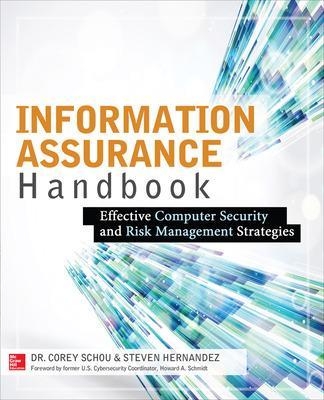
Information Assurance Handbook: Effective Computer Security and Risk Management Strategies
McGraw-Hill Professional (Verlag)
978-0-07-182165-0 (ISBN)
Publisher's Note: Products purchased from Third Party sellers are not guaranteed by the publisher for quality, authenticity, or access to any online entitlements included with the product.
Best practices for protecting critical data and systemsInformation Assurance Handbook: Effective Computer Security and Risk Management Strategies discusses the tools and techniques required to prevent, detect, contain, correct, and recover from security breaches and other information assurance failures. This practical resource explains how to integrate information assurance into your enterprise planning in a non-technical manner. It leads you through building an IT strategy and offers anorganizational approach to identifying, implementing, and controlling information assurance initiatives for small businesses and global enterprises alike.
Common threats and vulnerabilities are described and applicable controls based on risk profiles are provided. Practical information assurance application examples are presented for select industries, including healthcare, retail, and industrial control systems. Chapter-endingcritical thinking exercises reinforce the material covered. An extensive list of scholarly works and international government standards is also provided in this detailed guide.
Comprehensive coverage includes:
Basic information assurance principles and concepts
Information assurance management system
Current practices, regulations, and plans
Impact of organizational structure
Asset management
Risk management and mitigation
Human resource assurance
Advantages of certification, accreditation, and assurance
Information assurance in system development and acquisition
Physical and environmental security controls
Information assurance awareness, training, and education
Access control
Information security monitoring tools and methods
Information assurance measurements and metrics
Incident handling and computer forensics
Business continuity management
Backup and restoration
Cloud computing and outsourcing strategies
Information assurance big data concerns
Corey D. Schou, Ph.D., is the University Professor of Informatics and the Associate Dean of the College of Business at Idaho State University. He has been involved in establishing computer security and information assurance training and standards for 25 years. His research interests include information assurance, ethics, privacy, and collaborative decision making. He was responsible for compiling and editing computer security standards and training materials for the Committee on National Security Systems (CNSS). Throughout his career, Dr. Schou has remained an active classroom teacher despite his research and service commitments. He is the founding director of the Informatics Research Institute and the National Information Assurance Training and Education Center (NIATEC) that was designated the National Center of Excellence in Information Assurance Education. In 1996, his research center was cited by the Information Systems Security Association (ISSA) for Outstanding Contributions to the Security Profession and he was selected as the Educator of the Year by the Federal Information Systems Security Educators Association (FISSEA). In 1997, the Masie Institute and TechLearn Consortium recognized his contributions to distance education. In 2001, Dr. Schou was honored by the International Information Systems Security Certification Consortium [(ISC)2] with the Tipton award for his work in professionalization of computer security and his development of the generally accepted common body of knowledge (CBK) used in the certification of information assurance professionals. Dr. Schou serves as the chair of the Colloquium for Information Systems Security Education (CISSE). Under his leadership, the Colloquium creates an environment for exchange and dialogue among leaders in government, industry, and academia concerning information security and information assurance education. In addition, he is the editor of Information Systems Security and serves on the board of several professional organizations.
Part IInformation Security Infrastructure
1:The Need for Information Security
2:Concepts in Informaiton Security
3:Assets, Threats, Vulnerabilities, Risks, and Controls
4:Security Professionals and Organizations
5:Information Security management System
6:Implementing Information Security Strategy into Current Practices, Regulations, and Plans
Part IIInformation Security Planning Process
7:Approaches to Implementing Information Security
8:Organizational Structure for Mananging Information Security
9:Asset Management
10:Information Security Risk Management
11:Information Security Policy
12:Human Resouce Security
13:Certification, Accreditation, and Assurance
Part IIIInformation Security Prevention Process
14:Information Security in System Development
15:Physical and Environmental Security Controls
16:Information Security Awareness, Training, and Education
17:Preventive Tools and Techniques
18:Access Control
Part IVInformation Security Detection Process
19:Information Security Monitoring Tools and Methods
20:Information Security Measurements and Metrics
Part VInformation Security Recovery Process
21:Information Security Incident Handling
22:Computer Forensics
23:Business Continuity
24:Backup and Restoration
Appendices
| Erscheint lt. Verlag | 16.10.2014 |
|---|---|
| Zusatzinfo | 80 Illustrations |
| Sprache | englisch |
| Maße | 188 x 231 mm |
| Gewicht | 794 g |
| Themenwelt | Informatik ► Netzwerke ► Sicherheit / Firewall |
| Informatik ► Theorie / Studium ► Kryptologie | |
| ISBN-10 | 0-07-182165-1 / 0071821651 |
| ISBN-13 | 978-0-07-182165-0 / 9780071821650 |
| Zustand | Neuware |
| Haben Sie eine Frage zum Produkt? |
aus dem Bereich


